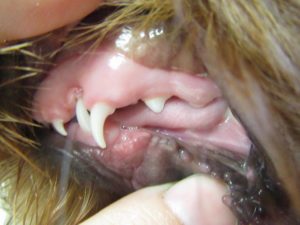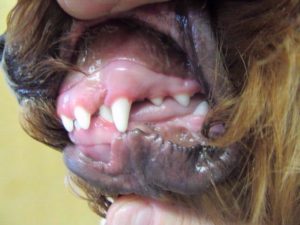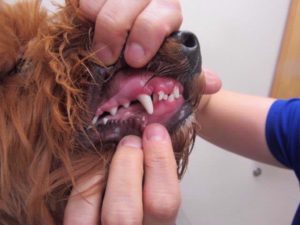
Max is a sweet, loving Goldendoodle puppy. He was brought to Hawthorne Hills Veterinary Hospital for his puppy vaccines and first checkup. During his oral exam it was found that his lower deciduous canine teeth did not erupt in the correct position. They were digging into his hard palate causing pain and if left untreated could even cause a fistula from the mouth into the nasal cavity.

This shows the left lower ‘baby’ canine tooth penetrating the upper gum line. This is painful and needs to be corrected immediately by extracting the lower tooth.
Since these were not Max’s permanent teeth and were causing pain, it was decided to extract both of these lower canine teeth. This would ensure they did not traumatize his hard palate and make room for his permanent canine teeth to erupt in their normal position.
Over the next few weeks Max’s teeth were monitored closely by his owner and veterinarian. Unfortunately, his permanent teeth also started erupting in an abnormal position. If left untreated this lower canine teeth would hit his hard palate causing pain, infection and ultimately an oronasal fistula. There is a short window of time where we can intervene and teeth can be moved into their proper position in the mouth.

On the left side, the lower adult canine tooth is poking into the gum between the upper incisor and upper canine tooth

Here you can see that the lower adult canine is still in the wrong position, barely visible and tucked behind the upper adult canine
We are able to move teeth in young dogs with Ball Therapy. Under the supervision of a veterinarian, a puppy is trained to bite down on a smooth ball. This is done multiple times daily to push the canine teeth out laterally. Owners can also use their fingers to apply pressure to the teeth as well.
Ball Therapy is a very effective, inexpensive and easy way to prevent a very painful condition. However, it only works when puppies are young (under 8-9 months of age). If the dog is an adult then this will not work and the options are extracting the teeth or crown shortening procedures. Both of these are much more invasive and the dog will be in pain until the teeth are corrected.

In this photo, the canine tooth is in the correct location. Max did ultimately, also require extraction of the upper incisor that was in the wrong position too.

max.canine.adult_-595×446
Ball therapy was successful for Max! Max’s mouth is now healthy and pain free!
It is important for your growing puppy to see their veterinarian regularly, so medical conditions can be detected early. If medical conditions are detected early, then there are typically more treatment options available and your pet can avoid painful conditions and remain healthy.
Resources: Lingually displaced mandibular canine teeth
VeterinaryPartner.com – Orthodontics for Pets
Fraser Hale, DVM, FAVD, DiplAVDC Ball Therapy Technique
Dental Vets UK – Lingually Displaced Canines
“This is genetically recessive and both parents must have the gene to pass it along to offspring. Consideration should be given to whether or not you breed a dog with this change. There is no genetic test as of yet; if puppies in a litter are affected, the most responsible thing is to refrain from breeding the parent dogs again, either as a pair or individually.”

